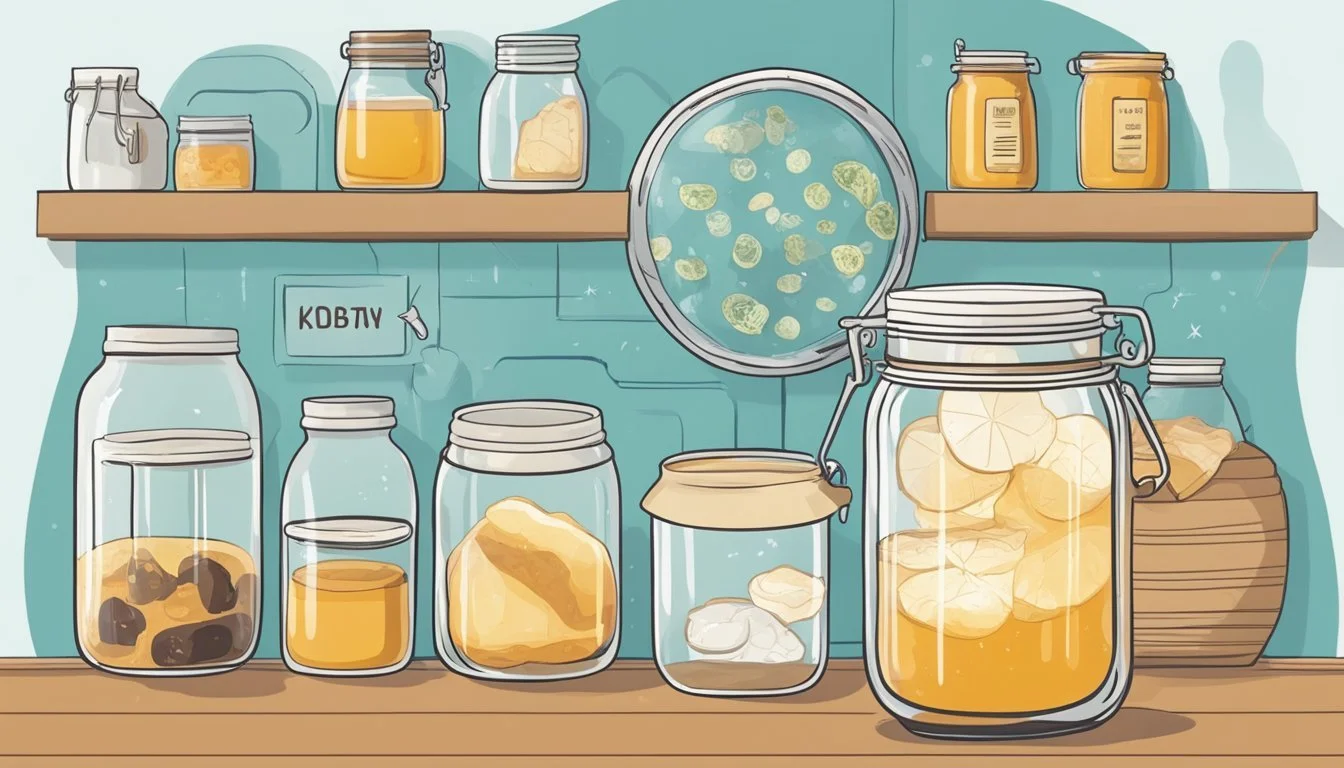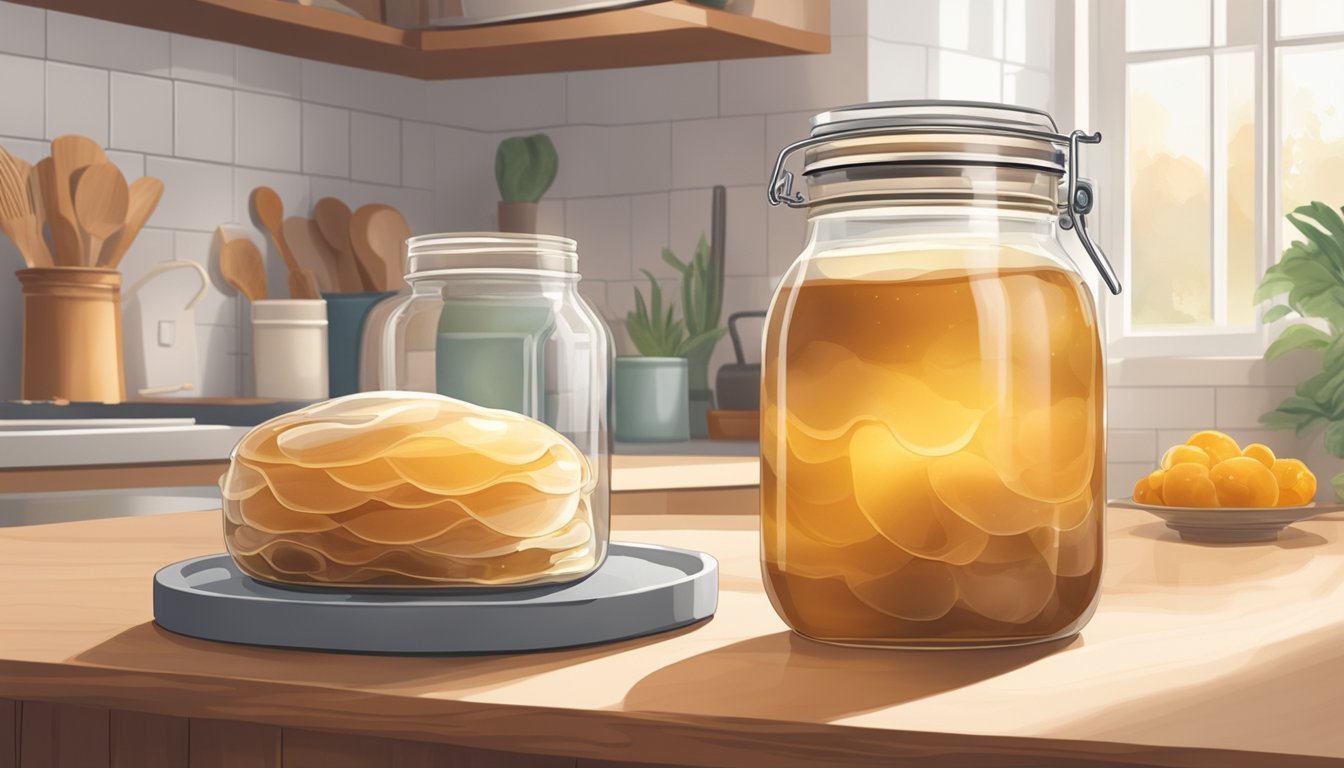How Long Does Kombucha SCOBY Last?
Shelf Life and Maintenance Tips
A kombucha SCOBY, which stands for Symbiotic Culture Of Bacteria and Yeast, is the essential ingredient in brewing the fermented tea known as kombucha. This living culture is the driving force behind the fermentation process, contributing to both the flavor and health benefits of the beverage. The lifespan of a SCOBY can be quite impressive, often lasting for many years if properly maintained.
In practical terms, while the parent SCOBY is long-lasting, home brewers typically use newer SCOBYs generated from recent batches to ensure optimal freshness and effectiveness. As the SCOBY ferments the tea, it produces new layers that can be used to start new batches. This continuous cycle means that, even though the original SCOBY has the potential to last indefinitely, it is frequently replaced well before it shows any signs of aging.
Care for the SCOBY is simple but important. Keeping it in a healthy environment with regular feedings of sweet tea allows the culture to thrive and ferment effectively. SCOBYs can survive periods of inactivity when stored correctly in a mixture of tea and its own acidic liquid, which protects it from mold and contamination. Observant brewers will notice signs, such as darkening or hardening of the culture, that indicate when a SCOBY might be reaching the end of its useful life and should be replaced.
Understanding Kombucha and SCOBY
Kombucha is a fermented beverage that is rich in probiotics, produced by fermenting sweetened tea with a symbiotic culture of bacteria and yeast (SCOBY). This fermentation process generates a distinctive tangy taste, yielding not only a probiotic drink but also a concoction containing vinegar, alcohol, and various acids beneficial for health.
SCOBY, an acronym for "Symbiotic Culture Of Bacteria and Yeast," is the essential component in kombucha brewing. It presents itself as a cellulose-based biofilm or pellicle and is responsible for the fermentation of the tea. The yeast in the SCOBY converts the sugar into alcohol, and the bacteria then convert the alcohol into acetic acid, which attributes the vinegar-like taste to the kombucha.
During fermentation, the SCOBY consumes the sugars, producing a range of substances:
Acids: such as acetic, lactic, and gluconic acids
Alcohol: generally in trace amounts
Carbon Dioxide: giving kombucha its effervescence
The SCOBY is a living entity, and with each batch of kombucha made, it creates a new layer or "baby" SCOBY. Over time, these layers can be separated and used to ferment new batches, making the SCOBY self-propagating. Typically, a healthy SCOBY can produce kombucha for several months to years, although brewers often use the newest growth to ensure the best quality of the subsequent batches.
Care & Longevity of SCOBY:
Darkening: A SCOBY tends to darken with age which is natural, but a very dark brown color may indicate it's too old.
Texture: It should be gel-like, not hard or rubbery.
Activity: Older SCOBYs may become inactive, indicated by the absence of fermentation or carbonation.
Understanding the SCOBY is crucial for successful kombucha brewing, enabling one to monitor the health and lifespan of this unique culture.
Brewing and Fermentation Process
In brewing Kombucha, the longevity and health of the SCOBY are pivotal. This section elaborates on the necessary steps and conditions for the SCOBY to thrive during the brewing and fermentation process.
Initial Brew Preparation
The brewing process begins with the initial brew preparation, where one combines sweet tea made from sugar and tea leaves with a starter tea. This mixture is the foundation for the Kombucha. It's essential that the sweet tea is cooled to room temperature before adding the SCOBY to avoid harming it. Typically, a recipe may call for the following proportions:
1 cup of sugar
8 bags of tea (or 2 tablespoons of loose tea)
1 gallon of water
2 cups of starter tea
Fermentation Stages
Fermentation stages are crucial for developing Kombucha's distinct flavor and health benefits. In the initial phase, the SCOBY digests the sugar, producing alcohol and organic acids. Oxygen plays an essential role in this aerobic process. This stage usually takes between 7 to 12 days and it can be broken down into two parts:
Aerobic fermentation (first 0-7 days): The SCOBY floats at the top, creating a seal that protects the brew and facilitates the exchange of gases.
Anaerobic fermentation (day 8 onwards): The alcohol levels slightly increase, and the SCOBY continues to produce acids, resulting in a decrease in pH and a tangy taste.
Batch Completion and SCOBY Removal
Once the fermentation process is complete, the brew should taste tart yet slightly sweet. At this stage, one can already remove the mature SCOBY along with some liquid to use as a starter culture for the next batch. The fermented tea can then be bottled for secondary fermentation or consumed as is. The SCOBY will often produce a new layer or "baby SCOBY" that can be used for subsequent brewing.
Proper SCOBY Care and Maintenance
Maintaining a healthy SCOBY is crucial for productive kombucha brewing. Successful care involves creating a stable environment, understanding long-term storage options like a SCOBY hotel, and tackling any common issues that may arise.
Creating a Healthy Environment
A SCOBY requires consistent conditions to thrive. The environment should have a room temperature consistently between 65-78 degrees F (18-25 degrees C) to promote proper fermentation. The container holding the SCOBY must be covered with a breathable fabric to prevent contaminants while allowing airflow. It is essential to keep the SCOBY out of direct sunlight as UV rays can damage it and interfere with fermentation.
SCOBY Hotel and Long-Term Storage
For long-term storage, a SCOBY hotel is an excellent option. In a clean jar, additional SCOBYs can be stored layered with sweetened tea and starter kombucha to keep them viable. The hotel should be covered with a few layers of tightly woven cloth secured with a rubber band, allowing the SCOBYs to breathe. Periodically, it’s necessary to remove the oldest layers of the SCOBY to prevent over-fermentation and mold.
Troubleshooting Common Issues
Mold growth can occur if the SCOBY is stored in improper conditions. A healthy SCOBY should not have a foul odor; a sour smell is normal, but anything reminiscent of rotten food indicates a problem. If a SCOBY becomes black or shows green fuzzy spots, it should be discarded. Consistent care and attention to the taste and appearance of the SCOBY and kombucha will alert one to most issues before they become significant.
Utilizing and Repurposing SCOBY
When it comes to Kombucha SCOBYs, they are not just one-time-use elements in the brewing process. Their life cycle extends beyond the creation of a single batch of Kombucha, offering opportunities for reuse in brewing and alternative applications.
SCOBY in Subsequent Batches
A Kombucha SCOBY (Symbiotic Culture Of Bacteria and Yeast) is a living entity that can be reused repeatedly, growing and dividing with each batch. One may remove the top, newer mother SCOBY layers to propagate the next batch of Kombucha, ensuring a continuous supply. It is typical for a SCOBY to remain active for 6-9 months when used to brew consecutively.
Active brewing lifespan: 6-9 months
Propagation: Removal of newer layers for next batch
Alternative Uses for SCOBY
Apart from brewing, SCOBYs have alternative uses. Their composition is rich in nutrients, which can be beneficial in other applications:
As a food source: SCOBYs can be dehydrated to make jerky or blended into smoothies.
In compost: Because they are organic and biodegradable, they can be added to a compost pile to enrich the soil.
For pets: Some pet owners have found SCOBYs to be a healthy treat for pets like chickens, after ensuring they are safe for the specific animal.
Disposal of Old SCOBY
When a SCOBY is too old for efficient fermentation, indicated by excessive darkening or becoming hard, it should be retired from brewing. Disposal methods include:
Compost: It can be broken down and added to compost.
Organic waste: Disposed of in organic waste bins.
Safety note: When handling SCOBY for any purpose, it should be done so with clean hands and tools to prevent contamination, frequently advisable to cover with a coffee filter to ensure breathability while keeping out contaminants.
Shelf Life and Quality Indicators
The shelf life of a kombucha SCOBY is impressive; it can often last for years. However, as they are living cultures, their potency does diminish over time. Quality indicators are essential to determine if a SCOBY is still viable.
Shelf Life: Typically, a SCOBY can last indefinitely if maintained properly. Brewers will find that a SCOBY grows new layers with each batch. The old layers can be peeled away, and new ones can be used to continue the fermentation process.
Expiration Date: Unlike store-bought foods, a SCOBY does not come with a set expiration date. Its 'expiry' depends largely on visual and tactile cues rather than a printed date. A SCOBY that appears overly dark, hard, or rubbery may be too old for effective use.
Quality Indicators include:
Odor: A healthy SCOBY will have a distinct but not unpleasant smell, often described as a vinegar or yeasty aroma. An off-putting or foul odor signifies that the SCOBY may be compromised.
Taste: Fermentation time directly influences taste, with a longer period resulting in a more acidic and less sweet kombucha. This acidic profile, reminiscent of vinegar, acts as a natural preservative.
Visual Inspection: Look for clear signs such as mold or unusual colorations. A dark brown SCOBY, for instance, might still be healthy, but one that turns black could indicate that it is no longer viable.
Those who brew will notice that the tart taste of the kombucha signifies an active and healthy SCOBY. When kombucha lacks the characteristic tartness or if its taste deviates significantly from previous batches, this could indicate a SCOBY losing its fermenting ability.
Refrigeration and Storage Options
When storing a kombucha SCOBY, individuals have various methods at their disposal, each suitable for different durations and circumstances. Refrigeration is one common technique for storing a kombucha SCOBY, particularly for short-term periods ranging from a few weeks to a couple of months. During refrigeration, the SCOBY enters a dormant state, which slows down the fermentation process.
Short-Term Refrigeration:
Duration: A few weeks to 2 months
Method: Place the SCOBY in a jar with starter tea
Temperature: Keep at consistent refrigerator temperatures
However, it is important to note that while refrigeration can keep a SCOBY dormant, some experts advise against it. They argue that refrigeration may introduce unnecessary risks, such as mold growth or a delayed reactivation of the SCOBY when brewing is resumed.
Room Temperature Storage:
Temperature Range: Around 68°F to 78°F (20°C to 26°C)
Environment: Acidic, to prevent mold and contamination
Refreshment: Replace a portion of the liquid with sweet tea every 6 weeks
For those choosing to store SCOBYs at room temperature, the process typically involves keeping it in slightly vinegary kombucha with periodic refreshment. By replacing three-quarters of the liquid with fresh sweet tea every six weeks, the SCOBY maintains an optimal acidic environment.
Determining the best storage option depends on one’s brewing schedule and preferences. Each method aims to keep the SCOBY viable and contamination-free until the next use.
SCOBY Health and Contamination Signs
A kombucha SCOBY (Symbiotic Culture Of Bacteria and Yeast) can last for months or even years with proper care, and its longevity is closely linked to its health. To prevent contamination and maintain a healthy SCOBY, one should be vigilant for signs of mold and harmful bacteria.
Positive Indicators of SCOBY Health:
The SCOBY is creamy or light tan in color and may darken slightly with age.
It's flexible and has a gelatinous texture.
A new, thin layer forms on the surface, indicating active fermentation.
Signs of Possible Contamination:
Mold Growth: This is often characterized by fuzzy spots that might appear in green, black, white, or blue. Unlike yeast strands that are normal in kombucha cultures, mold exhibits a powdery texture and is raised above the SCOBY's surface.
Harmful Bacteria: A pH above 4.5 in the brew is an unfavorable sign and can indicate the presence of harmful bacteria. Healthy kombucha should maintain a pH between 2.5 and 3.5.
Fruit Flies:
Presence indicates a breach in the fermenting environment’s sanitation.
Can introduce bacteria and spoilage organisms into the brew.
To Prevent Contamination:
Ensure the brewing area is clean and well-maintained.
Cover the fermentation vessel with a breathable cloth that keeps out insects and debris.
Monitor the SCOBY regularly for any signs of abnormality.
Should a SCOBY become contaminated, it must be discarded to avoid potential health risks. Observing these signs and ensuring cleanliness during the brewing process are paramount to maintaining a healthy SCOBY and producing quality kombucha.
Enhancing Kombucha Through Second Fermentation
The practice of conducting a second fermentation is a pivotal step for kombucha enthusiasts who aim to enrich their brew with unique flavors and a pleasant fizz. This stage permits further customization of taste while potentially adjusting the carbonation and alcohol level.
Flavoring with Fruits and Additional Ingredients
During second fermentation, fruit, herbs, or spices are often introduced to the kombucha to impart additional flavors. The specifics of the flavoring process entail:
Fruit content: Typically 10-20% of the bottle's volume is filled with fruit.
Herbs and spices: These should be used sparingly, as they can be overpowering.
The selection and combination of flavoring agents should be considered carefully to balance taste and enhance the overall sensory profile of the kombucha.
Managing Carbonation and Alcohol Content
Carbonation is developed naturally during the second fermentation as yeast consumes the sugars, releasing carbon dioxide. To manage carbonation:
Bottle headspace: Leave about ½ - 1 inch of space to allow for gas expansion.
Bottle type: Use airtight bottles fit for carbonation, such as swing-top glass bottles.
The level of alcohol can slightly increase during the second fermentation, but it generally remains low. Fermentation time can influence both:
Shorter fermentation: Leads to less carbonation and alcohol.
Longer fermentation: Increases both, typically over a 3-5 day period.
By monitoring these processes, brewers can ensure the kombucha is enhanced to their preference without compromising safety or quality.
SCOBY and the Home Environment
In the home environment, maintaining the SCOBY's health is crucial for successful kombucha brewing. Careful attention to the interaction with pets and prevention of pests such as fruit flies are key aspects to consider.
Pets and SCOBY Safety
It is essential to keep the SCOBY out of reach of household pets. Cats and dogs may be drawn to the scent of the fermenting kombucha and could contaminate or digest the SCOBY, which can be harmful to their health due to its bacterial composition.
Cats: Their curiosity might lead them to the fermenting vessel. Keep it covered and in a secure place.
Dogs: Can be attracted to the SCOBY's unusual texture and smell. Store the fermentation vessel in a height-restricted area to prevent access.
Preventing Fruit Fly Infestations
Fruit flies pose a significant threat to the kombucha fermentation process, as they are attracted to the sweet-smelling brew and can contaminate it.
Storage: Keep the SCOBY in an airtight container when not in use or during fermentation to prevent fruit flies from laying eggs.
Cleanliness: Regularly clean the brewing and fermentation area to ensure it doesn't attract fruit flies with spilled kombucha or sugars.
By following these specific guidelines, one can ensure the longevity of their SCOBY and the safety of their home environment during the kombucha brewing process.
Frequently Asked Questions (FAQs)
In this section, readers will find concise answers to common inquiries regarding the lifespan of kombucha SCOBY, the use of starter liquids, managing SCOBY layers, and the role of caffeine in kombucha brewing.
SCOBY Life Span
A kombucha SCOBY can last for several years with proper care. Typically, a SCOBY is capable of fermenting numerous batches, but signs such as dark brown coloration or a hard, rubbery texture suggest it might be time to replace it.
Usage of Starter Liquids
Starter liquid is crucial for initiating fermentation in a new batch of kombucha. It contains beneficial bacteria and yeast from a previous batch, which should be vigorous and unpasteurized to effectively begin the brewing process.
Handling Multiple Layers of SCOBY
As SCOBY ferments tea, it creates new layers. These layers should be carefully separated, with the newer growth used for subsequent batches, ensuring robust and active fermentation.
Effects of Caffeine in Kombucha
Caffeine is present in kombucha as it is brewed from tea. However, the fermentation process may reduce caffeine levels slightly. It is essential to note that the caffeine content in the finished kombucha will vary based on the type of tea used and the length of fermentation.
Additional Resources and Products
For individuals keen on starting their own kombucha brewing journey or looking to sustain their current SCOBY, a variety of resources and products are available to support the process. When it comes to purchasing supplies, Amazon is a one-stop-shop offering a wide range of items including starter cultures and unflavored kombucha, which can be used to grow a new SCOBY.
A starter culture is essential for those starting from scratch. It contains the live bacteria and yeast needed to kickstart the fermentation process. These cultures often come with detailed instructions to ensure success.
Kombucha Starter Cultures: Available for beginners to easily initiate the process.
Find on Amazon: Kombucha Starter Culture
For continued growth and maintenance of a healthy SCOBY, one may consider supplementing with additional probiotics. These can help maintain a robust and active culture.
Probiotic Supplements: Can support SCOBY health and kombucha quality.
Find on Amazon: Daily Probiotic Supplement
For those preferring to avoid the initial brewing steps, unflavored kombucha can be used as a starter tea to develop a SCOBY.
Unflavored Kombucha: Can be used as a safe and effective starting liquid.
Find on Amazon: Organic Raw Unflavored Kombucha
Moreover, for readers seeking comprehensive guides or recipes, Amazon provides a multitude of books and e-books. Each resource is filled with tips, tricks, and best practices for SCOBY care and kombucha brewing techniques.
Kombucha Brewing Guides: To expand knowledge and brewing skills.
Top Picks: The Big Book of Kombucha: Brewing, Flavoring, and Enjoying the Health Benefits of Fermented Tea
Note: Always ensure that the provided information aligns with the most current and reputable sources before making kombucha at home, as SCOBY health is critical to successful brewing and food safety.









